Prediction of Soil Water Content and Electrical Conductivity Using Random Forest Methods with UAV Multispectral and Ground-Coupled Geophysical Data
Abstract
:1. Introduction
2. Materials and Methods
2.1. Study Area
2.2. Vegetation Indices Data Acquisition and Processing
2.3. Volumetric Water Content from Ground-Penetrating Radar
2.4. Electrical Conductivity from Electromagnetic Induction
2.5. Resolving Resolution Differences between Multispectral and Geophysical Data
2.6. Machine Learning
3. Results
3.1. Maps of Each of the Vegetation Indices, Raw Band Data, Volumetric Water Content (VWC) and Electrical Conductivity (EC)
3.2. Evaluation of Prior Site Knowledge for Estimating Soil Properties Using UAV-Based Multispectral Data
3.2.1. Prediction of VWC and EC Using All Data, Undifferentiated by Crop Type or Drainage
3.2.2. Prediction of VWC and EC if Only the Drainage Tile Configuration Is Known
3.2.3. Prediction of VWC and EC if Only the Crop Type Is Known
3.2.4. Prediction of VWC and EC if Both the Crop Type and Drainage Configuration Are Known
3.3. Evaluation of Different UAV-Based Multispectral Data for Estimating Soil Properties
3.3.1. Evaluation of Individual Vegetation Indices for Predicting VWC and EC
3.3.2. Evaluation of Raw Band Data for Predicting VWC and EC
4. Discussion
4.1. Prediction of Soil Properties Using VIs Data
4.1.1. Prediction of VWC and EC Using All Data, Undifferentiated by Crop Type or Drainage
4.1.2. Prediction of VWC and EC if Only the Drainage Tile Configuration Is Known
4.1.3. Prediction of VWC and EC if Only the Crop Type Is Known
4.1.4. Prediction of VWC and EC if Both the Crop Type and Drainage Configuration Are Known
4.2. Evaluation of Different Multispectral Data for Estimating Soil Properties
4.2.1. Evaluation of Individual Vegetation Indices for Predicting VWC and EC
4.2.2. Evaluation of Raw Band Data for Predicting VWC and EC
5. Conclusions
Author Contributions
Funding
Data Availability Statement
Acknowledgments
Conflicts of Interest
References
- Corwin, D.; Lesch, S. Application of Soil Electrical Conductivity to Precision Agriculture. Agron. J. 2003, 95, 455–471. [Google Scholar] [CrossRef]
- Guo, W.; Maas, S.; Bronson, K. Relationship between cotton yield and soil electrical conductivity, topography, and Landsat imagery. Precis. Agric. 2012, 13, 678–692. [Google Scholar] [CrossRef]
- Wiatrak, P.; Khalilian, A.; Mueller, J.; Henderson, W. Applications of Soil Electrical Conductivity In Production Agriculture. Better Crops 2009, 93, 16–17. [Google Scholar]
- Robinson, D.; Lebron, I.; Kocar, B.; Phan, K.; Sampson, M.; Crook, N.; Fendorf, S. Time-lapse geophysical imaging of soil moisture dynamics in tropical deltaic soils: An aid to interpreting hydrological and geochemical processes. Water Resour. Res. 2009, 45. [Google Scholar] [CrossRef]
- Stadler, A.; Rudolph, S.; Kupisch, M.; Langensiepen, M.; van der Kruk, J.; Ewert, F. Quantifying the effects of soil variability on crop growth using apparent soil electrical conductivity measurements. Eur. J. Agron. 2015, 64, 8–20. [Google Scholar] [CrossRef]
- Bittelli, M. Measuring Soil Water Content: A Review. HortTechnology 2011, 21, 293–300. [Google Scholar] [CrossRef]
- Chan, D.; Rajeev, P.; Gallage, C.; Kodikara, J. Taiwan Ge-Otechnical Society/Southeast Asian Geotechnical Society. In Proceedings of the Seventeenth Southeast Asian Geotechnical Conference, Taipei, Taiwan, 10–13 May 2010; pp. 92–95. [Google Scholar]
- Evett, S.; Parkin, G. Advances in Soil Water Content Sensing: The Continuing Maturation of Technology and Theory. Vadose Zone J. 2005, 4, 986–991. [Google Scholar] [CrossRef]
- Gardner, C.; Dean, T.; Cooper, J. Soil Water Content Measurement with a High-Frequency Capacitance Sensor. J. Agric. Eng. Res. 1998, 71, 395–403. [Google Scholar] [CrossRef]
- Huisman, J.; Sperl, C.; Bouten, W.; Verstraten, J. Soil water content measurements at different scales: Accuracy of time domain reflectometry and ground-penetrating radar. J. Hydrol. 2001, 245, 48–58. [Google Scholar] [CrossRef]
- Piikki, K.; Söderström, M.; Wetterlind, J.; Stenberg, B. Digital Soil Mapping for Modelling of Transport Pathways for Pesticides to Surface Water; Swedish University of Agricultural Sciences: Uppsala, Sweden, 2015. [Google Scholar]
- Robinson, D.; Gardner, C.; Cooper, J. Measurement of relative permittivity in sandy soils using TDR, capacitance and theta probes: Comparison, including the effects of bulk soil electrical conductivity. J. Hydrol. 1999, 223, 198–211. [Google Scholar] [CrossRef]
- Robinson, D.; Jones, S.; Wraith, J.; Or, D.; Friedman, S. A review of advances in dielectric and electrical conductivity measurement in soils using time domain reflectometry. Vadose Zone J. 2003, 2, 444. [Google Scholar] [CrossRef]
- Walker, J.; Willgoose, G.; Kalma, J. In Situ Measurement of Soil Moisture: A Comparison of Techniques. J. Hydrol. 2004, 293, 85–99. [Google Scholar] [CrossRef]
- Huisman, J.; Hubbard, S.; Redman, J.; Annan, A. Measuring Soil Water Content with Ground Penetrating Radar: A Review. Vadose Zone J. 2003, 2, 476–491. [Google Scholar] [CrossRef]
- Klotzsche, A.; Jonard, F.; Looms, M.; van der Kruk, J.; Huisman, J. Measuring Soil Water Content with Ground Penetrating Radar: A Decade of Progress. Vadose Zone J. 2018, 17, 180052–180059. [Google Scholar] [CrossRef] [Green Version]
- Zajícová, K.; Chuman, T. Application of ground penetrating radar methods in soil studies: A review. Geoderma 2019, 343, 116–129. [Google Scholar] [CrossRef]
- Corwin, D.; Lesch, S.; Shouse, P.; Soppe, R.; Ayars, J. Identifying Soil Properties That Influence Cotton Yield Using Soil Sampling Directed by Apparent Soil Electrical Conductivity. Agron. J. 2003, 95, 352. [Google Scholar] [CrossRef] [Green Version]
- Corwin, D.; Lesch, S. Apparent soil electrical conductivity measurements in agriculture. Comput. Electron. Agric. 2005, 46, 11–43. [Google Scholar] [CrossRef]
- Lech, M.; Fronczyk, J.; Radziemska, M.; Podlasek, A.; Kazimierz, G.; Koda, E.; Lechowicz, Z. Monitoring of Total Dissolved Solids on Agricultural Lands Using Electrical Conductivity Measurements. Appl. Ecol. Environ. Res. 2016, 14, 285–295. [Google Scholar] [CrossRef]
- Yuzugullu, O.; Lorenz, F.; Fröhlich, P.; Liebisch, F. Understanding Fields by Remote Sensing: Soil Zoning and Property Mapping. Remote Sens. 2020, 12, 1116. [Google Scholar] [CrossRef] [Green Version]
- Vaudour, E.; Gomez, C.; Fouad, Y.; Lagacherie, P. Sentinel-2 image capacities to predict common topsoil properties of temperate and Mediterranean agroecosystems. Remote Sens. Environ. 2019, 223, 21–33. [Google Scholar] [CrossRef]
- Castaldi, F.; Chabrillat, S.; Van Wesemael, B. Sampling Strategies for Soil Property Mapping Using Multispectral Sentinel-2 and Hyperspectral EnMAP Satellite Data. Remote Sens. 2019, 11, 309. [Google Scholar] [CrossRef] [Green Version]
- Santaga, F.S.; Agnelli, A.; Leccese, A.; Vizzari, M. Using Sentinel-2 for Simplifying Soil Sampling and Mapping: Two Case Studies in Umbria, Italy. Remote Sens. 2021, 13, 3379. [Google Scholar] [CrossRef]
- Ramos, T.B.; Castanheira, N.; Oliveira, A.R.; Paz, A.M.; Darouich, H.; Simionesei, L.; Farzamian, M.; Gonçalves, M.C. Soil salinity assessment using vegetation indices derived from Sentinel-2 multispectral data. application to Lezíria Grande, Portugal. Agric. Water Manag. 2020, 241, 106387. [Google Scholar] [CrossRef]
- Zribi, M.; Nativel, S.; Le Page, M. Analysis of Agronomic Drought in a Highly Anthropogenic Context Based on Satellite Monitoring of Vegetation and Soil Moisture. Remote Sens. 2021, 13, 2698. [Google Scholar] [CrossRef]
- Yang, Y.; Zhang, J.; Bao, Z.; Ao, T.; Wang, G.; Wu, H.; Wang, J. Evaluation of Multi-Source Soil Moisture Datasets over Central and Eastern Agricultural Area of China Using in Situ Monitoring Network. Remote Sens. 2021, 13, 1175. [Google Scholar] [CrossRef]
- Jia, Y.; Jin, S.; Savi, P.; Yan, Q.; Li, W. Modeling and Theoretical Analysis of GNSS-R Soil Moisture Retrieval Based on the Random Forest and Support Vector Machine Learning Approach. Remote Sens. 2020, 12, 3679. [Google Scholar] [CrossRef]
- Han, L.; Wang, C.; Yu, T.; Gu, X.; Liu, Q. High-Precision Soil Moisture Mapping Based on Multi-Model Coupling and Background Knowledge, Over Vegetated Areas using Chinese GF-3 and GF-1 Satellite Data. Remote Sens. 2020, 12, 2123. [Google Scholar] [CrossRef]
- Babaeian, E.; Sadeghi, M.; Jones, S.; Montzka, C.; Vereecken, H.; Tuller, M. Ground, Proximal, and Satellite Remote Sensing of Soil Moisture. Rev. Geophys. 2019, 57, 530–616. [Google Scholar] [CrossRef] [Green Version]
- Gangat, R.; van Deventer, H.; Naidoo, L.; Adam, E. Estimating Soil Moisture Using Sentinel-1 and Sentinel-2 Sensors for Dryland and Palustrine Wetland Areas. S. Afr. J. Sci. 2020, 116, 1–9. [Google Scholar] [CrossRef]
- Liu, Y.; Qian, J.; Yue, H. Comprehensive Evaluation of Sentinel-2 Red Edge and Shortwave-Infrared Bands to Estimate Soil Moisture. IEEE J. Sel. Top. Appl. Earth Obs. Remote Sens. 2021, 14, 7448–7465. [Google Scholar] [CrossRef]
- Phiri, D.; Simwanda, M.; Salekin, S.; Nyirenda, V.R.; Murayama, Y.; Ranagalage, M. Sentinel-2 Data for Land Cover/Use Mapping: A Review. Remote Sens. 2020, 12, 2291. [Google Scholar] [CrossRef]
- Sentinel-2—Missions—Sentinel Online. Available online: https://sentinel.esa.int/web/sentinel/missions/sentinel-2 (accessed on 11 June 2021).
- Sentinel 2—Bands and Combinations—GIS Geography. Available online: https://gisgeography.com/sentinel-2-bands-combinations/ (accessed on 11 January 2021).
- Aboutalebi, M.; Allen, L.N.; Torres-Rua, A.F.; McKee, M.; Coopmans, C. Estimation of soil moisture at different soil levels using machine learning techniques and unmanned aerial vehicle (UAV) multispectral imagery. In Autonomous Air and Ground Sensing Systems for Agricultural Optimization and Phenotyping IV; Thomasson, J.A., McKee, M., Moorhead, R.J., Eds.; SPIE: Baltimore, MD, USA, 2019; Volume 11008, pp. 216–226. [Google Scholar] [CrossRef] [Green Version]
- Allred, B.; Eash, N.; Freeland, R.; Martinez, L.; Wishart, D. Effective and efficient agricultural drainage pipe mapping with UAS thermal infrared imagery: A case study. Agric. Water Manag. 2018, 197, 132–137. [Google Scholar] [CrossRef]
- Allred, B.; Martinez, L.; Fessehazion, M.; Rouse, G.; Williamson, T.; Wishart, D.; Koganti, T.; Freeland, R.; Eash, N.; Batschelet, A.; et al. Overall results and key findings on the use of UAV visible-color, multispectral, and thermal infrared imagery to map agricultural drainage pipes. Agric. Water Manag. 2020, 232, 106036. [Google Scholar] [CrossRef]
- Freeland, R.; Allred, B.; Eash, N.; Martinez, L.; Wishart, D. Agricultural drainage tile surveying using an unmanned aircraft vehicle paired with Real-Time Kinematic positioning—A case study. Comput. Electron. Agric. 2019, 165, 104946. [Google Scholar] [CrossRef]
- Ge, X.; Wang, J.; Ding, J.; Cao, X.; Zhang, Z.; Liu, J.; Li, X. Combining UAV-based hyperspectral imagery and machine learning algorithms for soil moisture content monitoring. PeerJ 2019, 7, e6926. [Google Scholar] [CrossRef]
- Gu, H.; Lin, Z.; Guo, W.; Deb, S. Retrieving Surface Soil Water Content Using a Soil Texture Adjusted Vegetation Index and Unmanned Aerial System Images. Remote Sens. 2021, 13, 145. [Google Scholar] [CrossRef]
- Hassan-Esfahani, L.; Torres-Rua, A.; Jensen, A.; McKee, M. Assessment of Surface Soil Moisture Using High-Resolution Mul-ti-Spectral Imagery and Artificial Neural Networks. Remote Sens. 2015, 7, 2627–2646. [Google Scholar] [CrossRef] [Green Version]
- Sona, G.; Passoni, D.; Pinto, L.; Pagliari, D.; Masseroni, D.; Ortuani, B.; Facchi, A. UAV Multispectral Survey to Map Soil and Crop for Precision Farming Applications; International Society for Photogrammetry and Remote Sensing (ISPRS): Nice, France, 2016; Volume XLI-B1, pp. 1023–1029. [Google Scholar]
- Williamson, T.; Dobrowolski, E.; Meyer, S.; Frey, J.; Allred, B. Delineation of Tile-Drain Networks Using Thermal and Mul-tispectral Imagery—Implications for Water Quantity and Quality Differences from Paired Edge-of-Field Sites. J. Soil Water Conserv. 2018, 74, 1–11. [Google Scholar] [CrossRef] [Green Version]
- Yeom, J.; Jung, J.; Chang, A.; Ashapure, A.; Maeda, M.; Maeda, A.; Landivar, J. Comparison of Vegetation Indices Derived from UAV Data for Differentiation of Tillage Effects in Agriculture. Remote Sens. 2019, 11, 1548. [Google Scholar] [CrossRef] [Green Version]
- Zhang, C.; Kovacs, J. The application of small unmanned aerial systems for precision agriculture: A review. Precis. Agric. 2012, 13, 693–712. [Google Scholar] [CrossRef]
- Daponte, P.; Vito, L.D.; Glielmo, L.; Iannelli, L.; Liuzza, D.; Picariello, F.; Silano, G. A Review on the Use of Drones for Precision Agriculture. IOP Conf. Ser. Earth Environ. Sci. 2019, 275, 012022. [Google Scholar] [CrossRef]
- Delgado Vera, C.; Aguirre Munizaga, M.; Jiménez, M.; Manobanda, N.; Rodríguez-Méndez, A. A Photogrammetry Software as a Tool for Precision Agriculture: A Case Study; Springer: Cham, Switzerland, 2017; pp. 282–295. [Google Scholar] [CrossRef]
- Govorcin, M.; Pribicevic, B.; Đapo, A. Comparison and Analysis of Software Solutions for Creation of a Digital Terrain Model Using Unmanned Aerial Vehicles. In Proceedings of the 14th International Multidisciplinary Scientific Geo-Conference and Expo 2014 (SGEM 2014), Albena, Bulgaria, 17–26 June 2014; Volume 3. [Google Scholar]
- Ziliani, M.; Parkes, S.; Hoteit, I.; McCabe, M. Intra-Season Crop Height Variability at Commercial Farm Scales Using a Fixed-Wing UAV. Remote Sens. 2018, 10, 2007. [Google Scholar] [CrossRef] [Green Version]
- Candiago, S.; Remondino, F.; De Giglio, M.; Dubbini, M.; Gattelli, M. Evaluating Multispectral Images and Vegetation Indices for Precision Farming Applications from UAV Images. Remote Sens. 2015, 7, 4026–4047. [Google Scholar] [CrossRef] [Green Version]
- Li, S.; Yuan, F.; Ata-Ui-Karim, S.; Zheng, H.; Cheng, T.; Liu, X.; Tian, Y.; Zhu, Y.; Cao, W.; Cao, Q. Combining Color Indices and Textures of UAV-Based Digital Imagery for Rice LAI Estimation. Remote Sens. 2019, 11, 1763. [Google Scholar] [CrossRef] [Green Version]
- Turner, D.; Lucieer, A.; Watson, C. Development of an Unmanned Aerial Vehicle (UAV) for hyper resolution vineyard mapping based on visible, multispectral, and thermal imagery. In Proceedings of the 34th International Symposium on Remote Sensing of Environment, Sydney, Australia, 10–15 April 2011. [Google Scholar]
- Zheng, H.; Cheng, T.; Li, D.; Zhou, X.; Yao, X.; Tian, Y.; Cao, W.; Zhu, Y. Evaluation of RGB, Color-Infrared and Multispectral Images Acquired from Unmanned Aerial Systems for the Estimation of Nitrogen Accumulation in Rice. Remote Sens. 2018, 10, 824. [Google Scholar] [CrossRef] [Green Version]
- Ramos, A.P.M.; Osco, L.P.; Furuya, D.E.G.; Gonçalves, W.N.; Santana, D.C.; Teodoro, L.P.R.; da Silva Junior, C.A.; Capristo-Silva, G.F.; Li, J.; Baio, F.H.R.; et al. A Random Forest Ranking Approach to Predict Yield in Maize with UAV-Based Vegetation Spectral Indices. Comput. Electron. Agric. 2020, 178, 105791. [Google Scholar] [CrossRef]
- Olson, D.; Chatterjee, A.; Franzen, D.; Day, S. Relationship of Drone-Based Vegetation Indices with Corn and Sugarbeet Yields. Agron. J. 2019, 111, 2545–2557. [Google Scholar] [CrossRef]
- Zhou, X.; Zheng, H.; Xu, X.; He, J.; Ge, X.; Yao, X.; Cheng, T.; Zhu, Y.; Cao, W.; Tian, Y. Predicting grain yield in rice using multi-temporal vegetation indices from UAV-based multispectral and digital imagery. ISPRS J. Photogramm. Remote Sens. 2017, 130, 246–255. [Google Scholar] [CrossRef]
- Ivushkin, K.; Bartholomeus, H.; Bregt, A.; Pulatov, A.; Franceschini, M.; Kramer, H.; van Loo, E.; Roman, V.J.; Finkers, R. UAV based soil salinity assessment of cropland. Geoderma 2019, 338, 502–512. [Google Scholar] [CrossRef]
- Easterday, K.; Kislik, C.; Dawson, T.; Hogan, S.; Kelly, M. Remotely Sensed Water Limitation in Vegetation: Insights from an Experiment with Unmanned Aerial Vehicles (UAVs). Remote Sens. 2019, 11, 1853. [Google Scholar] [CrossRef] [Green Version]
- Hoyos-Villegas, V.; Fritschi, F. Relationships Among Vegetation Indices Derived from Aerial Photographs and Soybean Growth and Yield. Crop Sci. 2013, 53, 2631–2642. [Google Scholar] [CrossRef]
- Rouse, J.; Haas, R.; Schell, J.; Deering, D. Monitoring vegetation systems in the Great Plains with ERTS. NASA Spec. Publ. 1974, 351, 309–317. [Google Scholar]
- Band Multispectral Band Math. Sentera. Retrieved 31 October 2019. Available online: https://sentera.com/ (accessed on 11 January 2021).
- Viña, A.; Gitelson, A.; Nguy-Robertson, A.; Peng, Y. Comparison of different vegetation indices for the remote assessment of green leaf area index of crops. Remote Sens. Environ. 2011, 115, 3468–3478. [Google Scholar] [CrossRef]
- Xue, J.; Su, B. Significant Remote Sensing Vegetation Indices: A Review of Developments and Applications. J. Sens. 2017, 2017, 1353691. [Google Scholar] [CrossRef] [Green Version]
- Barnes, E.; Clarke, T.; Richards, S.; Colaizzi, P.; Haberland, J.; Kostrzewski, M.; Waller, P.; Choi, C.; Riley, E.; Thompson, T.; et al. Coincident detection of crop water stress, nitrogen status and canopy density using ground based multispectral data. In Proceedings of the 5th International Conference on Precision Agriculture and Other Resource Management, Bloomington, MN, USA, 16–19 July 2000. [Google Scholar]
- Gitelson, A.; Gritz, Y.; Merzlyak, M. Relationships Between Leaf Chlorophyll Content and Spectral Reflectance and Algo-rithms for Non-Destructive Chlorophyll Assessment in Higher Plant Leaves. J. Plant Physiol. 2003, 160, 271–282. [Google Scholar] [CrossRef]
- Gitelson, A.; Kaufman, Y.; Merzlyak, M. Use of a green channel in remote sensing of global vegetation from EOS-MODIS. Remote Sens. Environ. 1996, 58, 289–298. [Google Scholar] [CrossRef]
- Gitelson, A.; Stark, R.; Grits, U.; Rundquist, D.; Kaufman, Y.; Derry, D. Vegetation and soil lines in visible spectral space: A concept and technique for remote estimation of vegetation fraction. Int. J. Remote Sens. 2002, 23, 2537–2562. [Google Scholar] [CrossRef]
- Jol, H. Ground Penetrating Radar Theory and Applications; Elsevier: Amsterdam, The Netherlands, 2009. [Google Scholar]
- Galagedara, L.; Redman, J.; Parkin, G.; Annan, A.; Endres, A. Numerical Modeling of GPR to Determine the Direct Ground Wave Sampling Depth. Vadose Zone J. 2005, 4, 1096–1106. [Google Scholar] [CrossRef]
- Grote, K.; Hubbard, S.; Rubin, Y. Field-scale estimation of volumetric water content using ground-penetrating radar ground wave techniques. Water Resour. Res. 2003, 39, SBH5-1–SBH5-13. [Google Scholar] [CrossRef] [Green Version]
- Lu, Y.; Song, W.; Lu, J.; Wang, X.; Tan, Y. An Examination of Soil Moisture Estimation Using Ground Penetrating Radar in Desert Steppe. Water 2017, 9, 521. [Google Scholar] [CrossRef] [Green Version]
- Kummode, S.; Thitimakorn, T.; Sasikan, K. Determination of the Volumetric Soil Water Content of Two Soil Types Using Ground Penetrating Radar: A Case Study in Thailand. Environ. Asia 2020, 12, 78–87. [Google Scholar]
- Weihermüller, L.; Huisman, J.; Lambot, S.; Herbst, M.; Vereecken, H. Mapping the spatial variation of soil water content at the field scale with different ground penetrating radar techniques. J. Hydrol. 2007, 340, 205–216. [Google Scholar] [CrossRef] [Green Version]
- Reppert, P.; Morgan, F.; Toksöz, M. Dielectric Constant Determination Using Ground-Penetrating Radar Reflection Coefficients. J. Appl. Geophys. 2000, 43, 189–197. [Google Scholar] [CrossRef]
- Robinson, D. Measurement of the Solid Dielectric Permittivity of Clay Minerals And Granular Samples Using A Time Domain Reflectometry Immersion Method. Vadose Zone J. 2004, 3, 705–713. [Google Scholar] [CrossRef]
- Jacobsen, O.; Schjønning, P. Field evaluation of time domain reflectometry for soil water measurements. J. Hydrol. 1993, 151, 159–172. [Google Scholar] [CrossRef]
- Roth, C.; Malicki, M.; Plagge, R. Empirical evaluation of the relationship between soil dielectric constant and volumetric water content as the basis for calibrating soil moisture measurements by TDR. Eur. J. Soil Sci. 1992, 43, 1–13. [Google Scholar] [CrossRef]
- Topp, G.; Davis, J.; Annan, A. Electromagnetic determination of soil water content: Measurements in coaxial transmission lines. Water Resour. Res. 1980, 16, 574–582. [Google Scholar] [CrossRef] [Green Version]
- Grote, K.; Crist, T.; Nickel, C. Experimental estimation of the GPR groundwave sampling depth. Water Resour. Res. 2010, 46. [Google Scholar] [CrossRef] [Green Version]
- Lund, E.; Christy, C.; Drummond, P. Using Yield and Soil Electrical Conductivity (EC) Maps to Derive Crop Production Performance Information. In Proceedings of the 5th International Conference on Precision Agriculture, Bloomington, MN, USA, 16–19 July 2000. [Google Scholar]
- Molin, J.; Faulin, G. Spatial and temporal variability of soil electrical conductivity related to soil moisture. Sci. Agricola 2013, 70, 1–5. [Google Scholar] [CrossRef]
- Breiman, L. Random Forests. Mach. Learn. 2001, 45, 5–32. [Google Scholar] [CrossRef] [Green Version]
- Zhang, Y.; Sui, B.; Shen, H.; Ouyang, L. Mapping stocks of soil total nitrogen using remote sensing data: A comparison of random forest models with different predictors. Comput. Electron. Agric. 2019, 160, 23–30. [Google Scholar] [CrossRef]
- Yang, R.-M.; Zhang, G.-L.; Liu, F.; Lu, Y.-Y.; Yang, F.; Yang, F.; Yang, M.; Zhao, Y.-G.; Li, D.-C. Comparison of boosted regression tree and random forest models for mapping topsoil organic carbon concentration in an alpine ecosystem. Ecol. Indic. 2016, 60, 870–878. [Google Scholar] [CrossRef]
- Reflected Near-Infrared Waves|Science Mission Directorate. Available online: https://science.nasa.gov/ems/08_nearinfraredwaves (accessed on 15 September 2021).

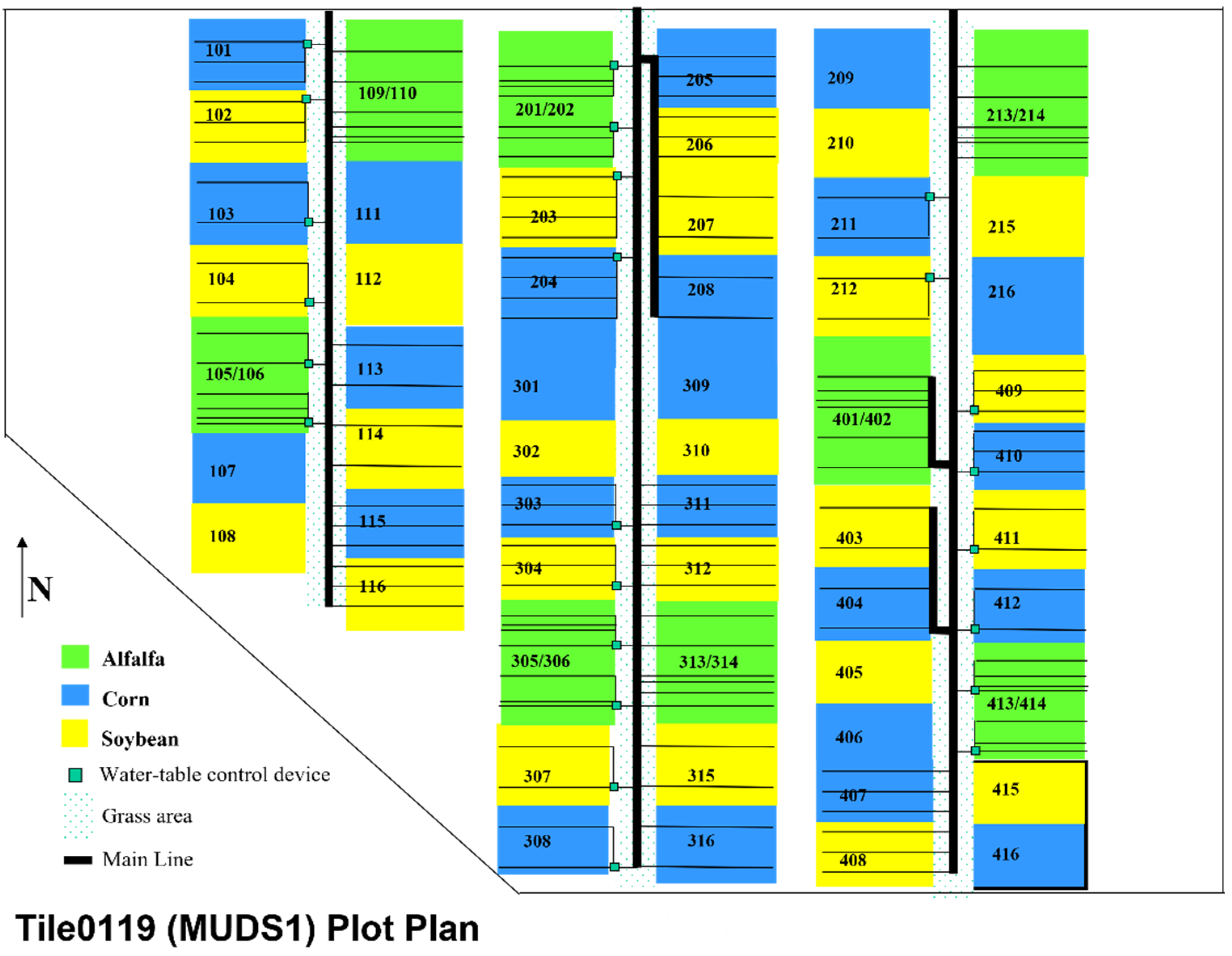
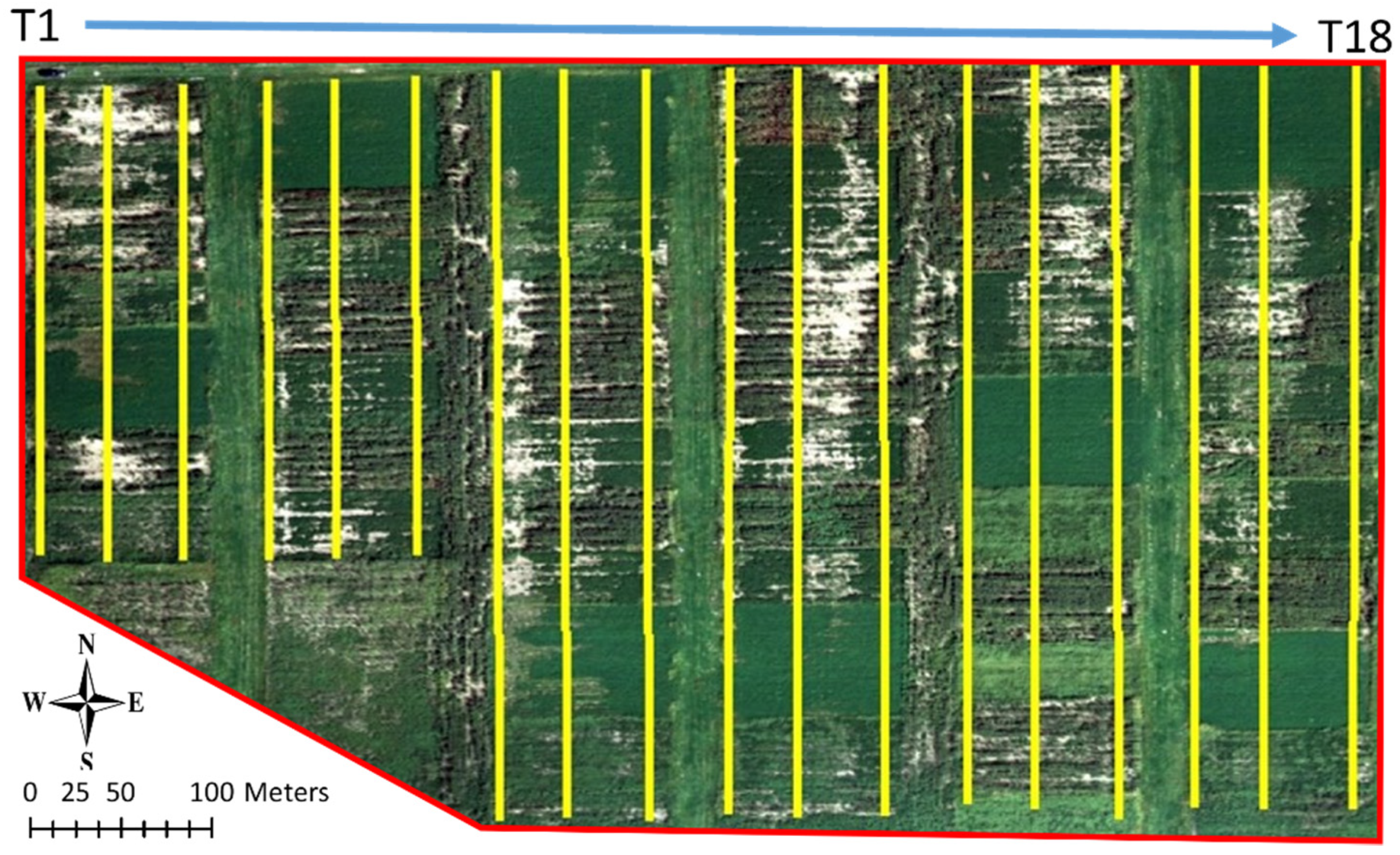
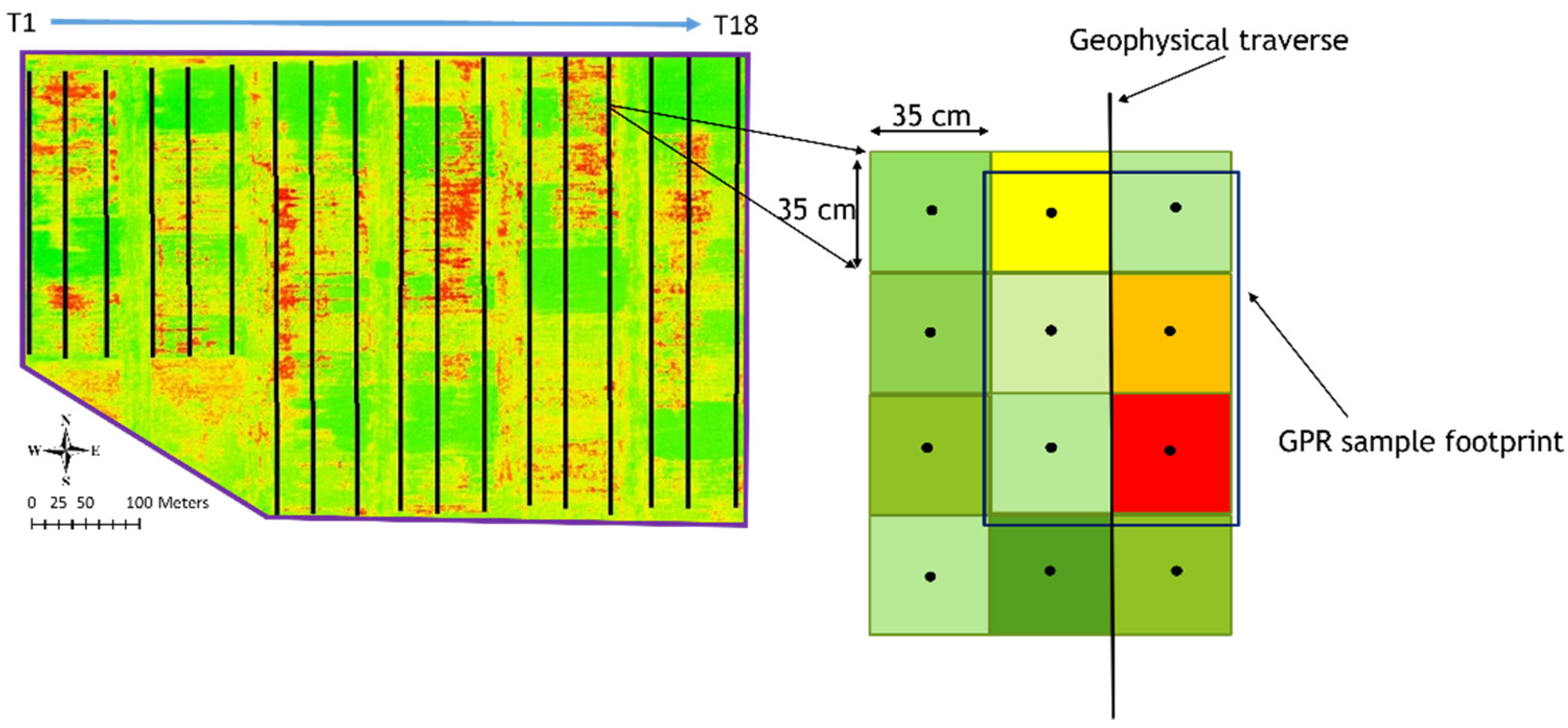
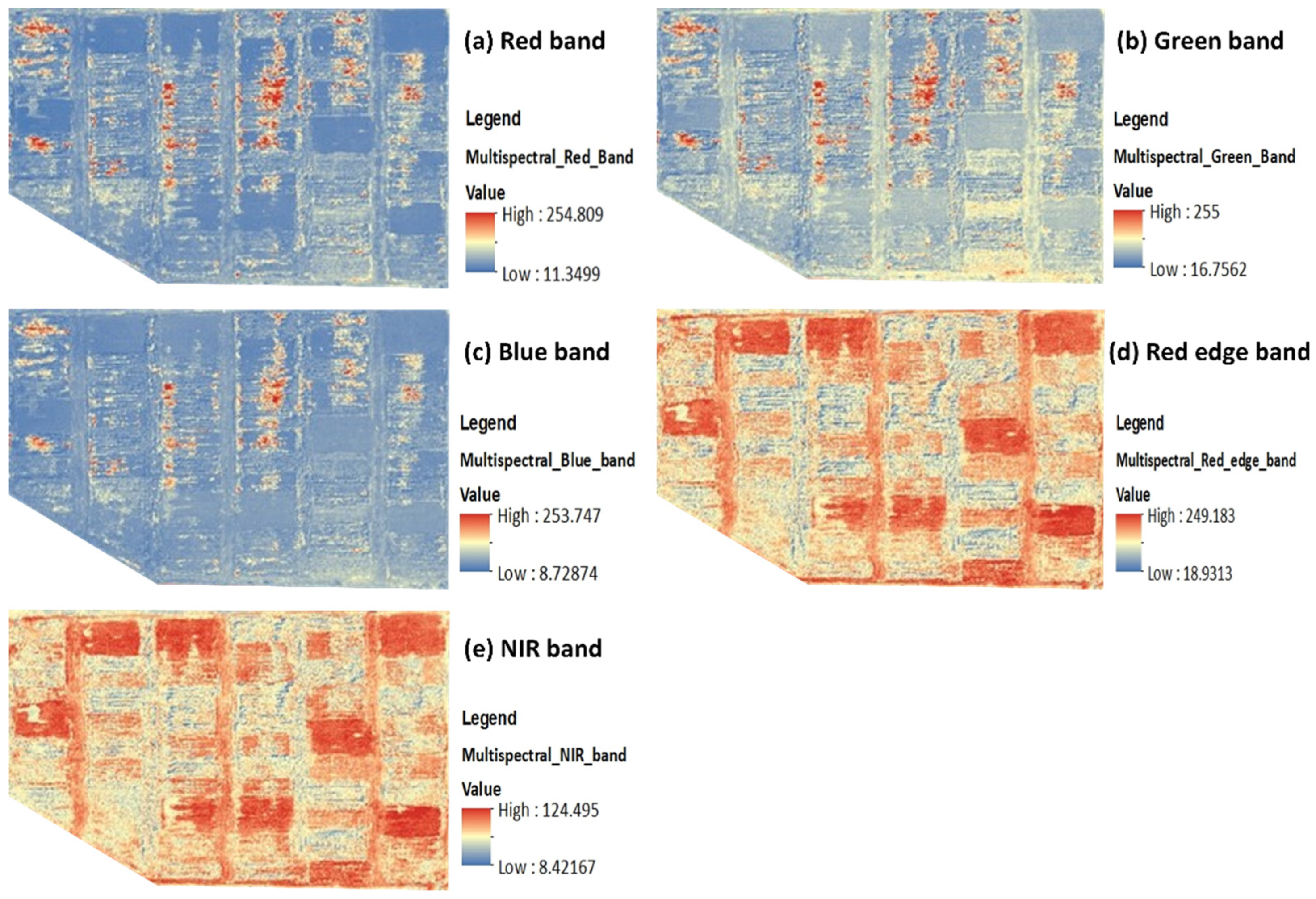
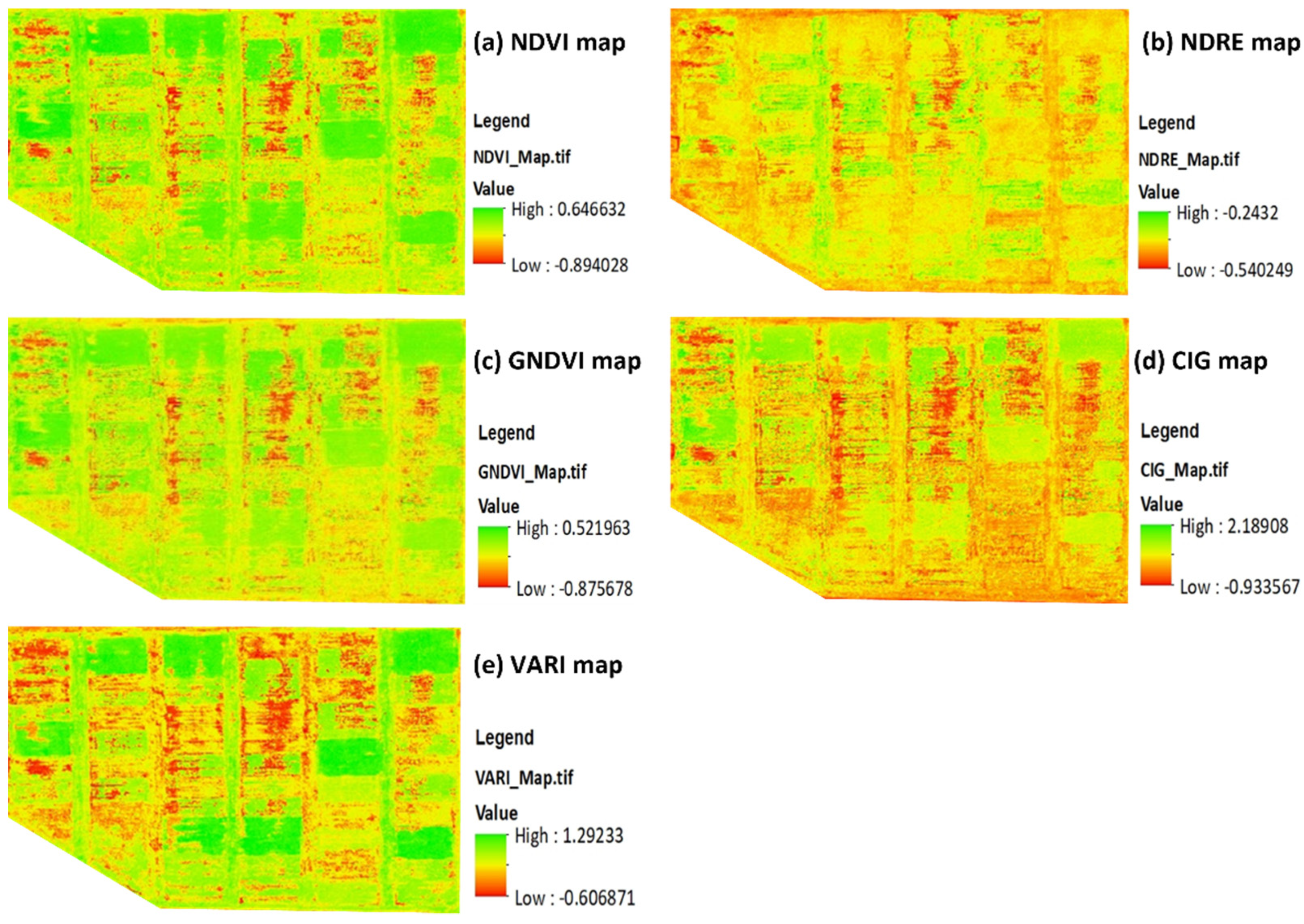
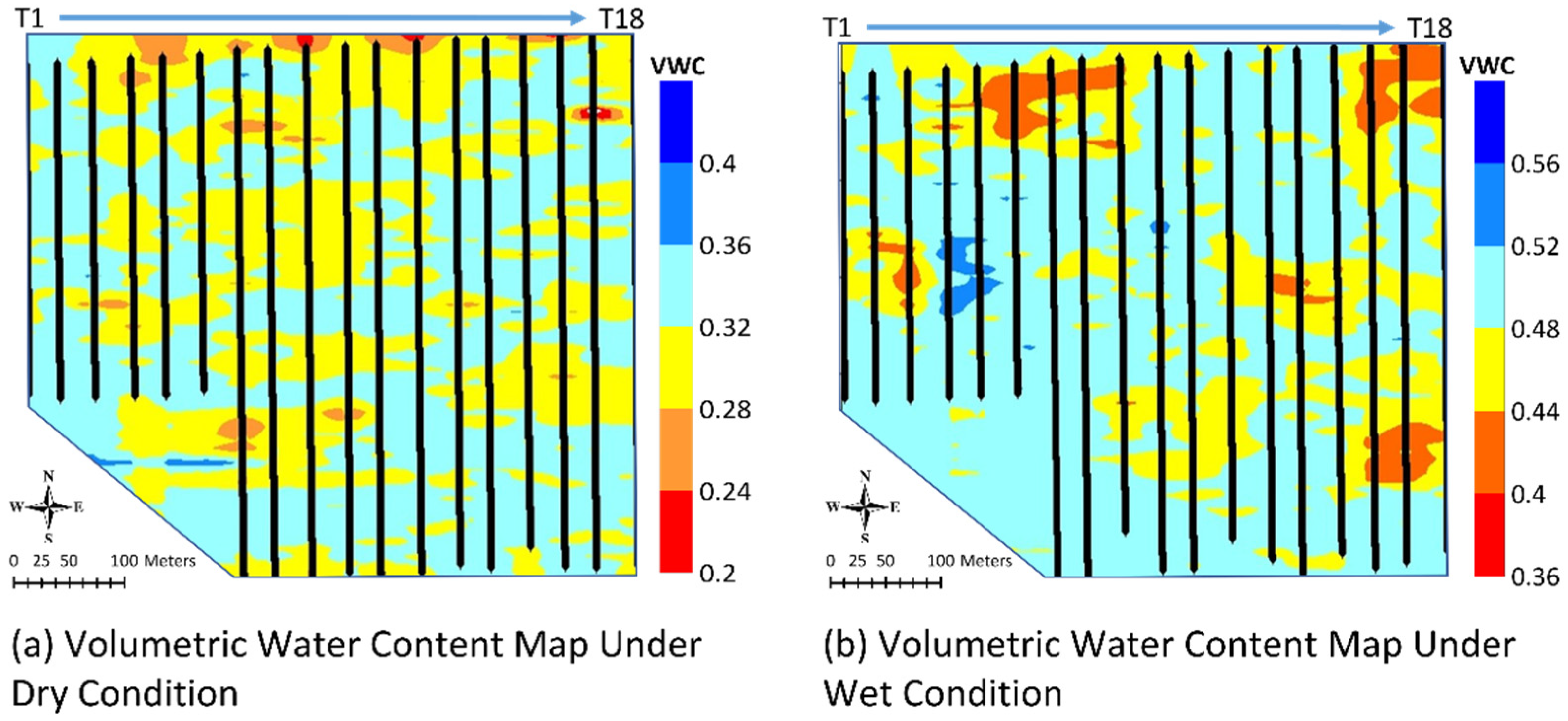
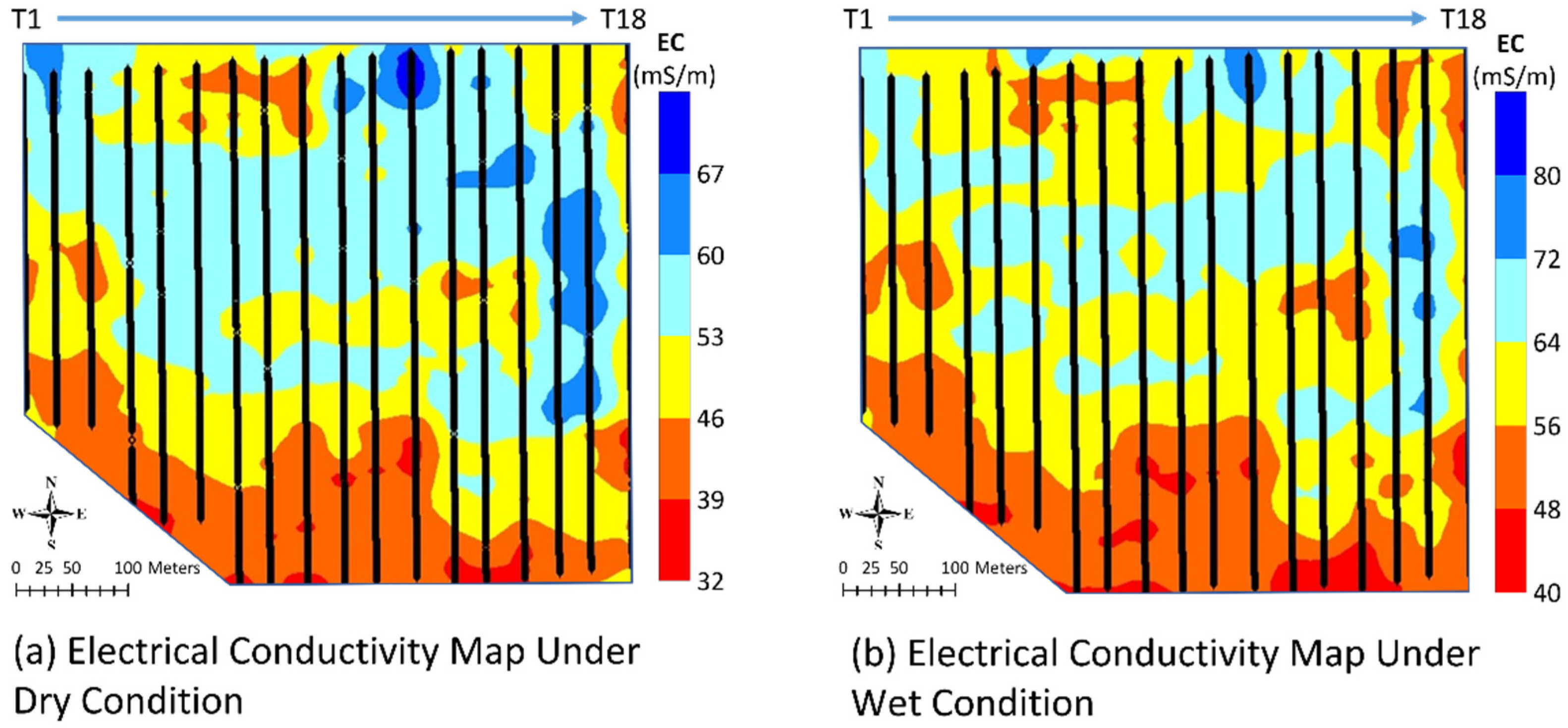
| Estimation of Soil Property from Multispectral UAV-Based Data | |
|---|---|
| Which types of a priori information result in the greatest improvement in soil property prediction | No a priori information |
| Drainage condition known | |
| Crop type known | |
| Both drainage condition and crop type known | |
| Which types of multispectral data are most important for soil property prediction | Different vegetation indices |
| Raw multispectral band data | |
| Vegetation Index | Equation | References |
|---|---|---|
| NDVI (Normalized Difference Vegetation Index) | NDVI = (NIR − Red)/(NIR + Red) | [61] |
| NDRE (Normalized Difference Red Edge Index) | NDRE = (NIR − Red Edge)/(NIR + Red Edge) | [65] |
| GNDVI (Green Normalized Difference Vegetation Index) | GNDVI = (NIR − Green)/(NIR + Green) | [67] |
| CIG (Chlorophyll Index Green) | CIG = (NIR/Green − 1) | [66] |
| VARI (Visible Atmospherically Resistant Index) | VARI = (Green − Red)/(Green + Red − Blue) | [68] |
| DRY, VWC, Only VI Data | WET, VWC, Only VI Data | |||||||
|---|---|---|---|---|---|---|---|---|
| Data Used | MAE | Mean | SD | Count | MAE | Mean | SD | Count |
| All crop types and all drainage tiles together | 0.0169 | 0.3197 | 0.0263 | 41,711 | 0.0173 | 0.4822 | 0.0288 | 41,480 |
| DRY, EC, Only VI data | WET, EC, Only VI data | |||||||
| Data Used | MAE (mS/m) | Mean (mS/m) | SD (mS/m) | Count | MAE (mS/m) | Mean (mS/m) | SD (mS/m) | Count |
| All crop types and all drainage tiles together | 4.1464 | 52.2497 | 6.6468 | 8201 | 4.5420 | 59.7565 | 7.1919 | 9747 |
| DRY, VWC, Only VI Data | WET, VWC, Only VI Data | |||||||
|---|---|---|---|---|---|---|---|---|
| Data Used | MAE | Mean | SD | Count | MAE | Mean | SD | Count |
| Corn and soybean data, no tile drainage | 0.0136 | 0.3233 | 0.0206 | 10,093 | 0.0116 | 0.4870 | 0.0190 | 10,098 |
| Corn and soybean data, 12.2 m tile spacing | 0.0137 | 0.3200 | 0.0221 | 11,390 | 0.0145 | 0.4913 | 0.0241 | 11,070 |
| Corn and soybean data, 6.1 m tile spacing | 0.0147 | 0.3172 | 0.0236 | 9228 | 0.0145 | 0.4885 | 0.0228 | 9377 |
| DRY, EC, Only VI Data | WET, EC, Only VI Data | |||||||
| Data Used | MAE (mS/m) | Mean (mS/m) | SD (mS/m) | Count | MAE (mS/m) | Mean (mS/m) | SD (mS/m) | Count |
| Corn and soybean data, no tile drainage | 3.8283 | 52.8527 | 5.6364 | 2230 | 4.1676 | 61.5233 | 6.1035 | 2179 |
| Corn and soybean data, 12.2 m tile spacing | 4.1381 | 53.1247 | 6.9050 | 2522 | 4.4927 | 61.1668 | 7.4361 | 2530 |
| Corn and soybean data, 6.1 m tile spacing | 3.9303 | 54.6599 | 6.1147 | 1951 | 4.1993 | 62.4027 | 6.8928 | 2089 |
| DRY, VWC, Only VI Data | WET, VWC, Only VI Data | |||||||
|---|---|---|---|---|---|---|---|---|
| Data Used | MAE | Mean | SD | Count | MAE | Mean | SD | Count |
| Corn, all drainage tile configurations | 0.0153 | 0.3155 | 0.0233 | 15,273 | 0.0154 | 0.4883 | 0.0233 | 15,127 |
| Soybeans, all drainage tile configurations | 0.0128 | 0.3249 | 0.0200 | 15,438 | 0.0136 | 0.4897 | 0.0210 | 15,418 |
| Alfalfa, all drainage tile configurations | 0.0203 | 0.3191 | 0.0370 | 9051 | 0.0190 | 0.4588 | 0.0359 | 9038 |
| DRY, EC, Only VI Data | WET, EC, Only VI Data | |||||||
| Data Used | MAE (mS/m) | Mean (mS/m) | SD (mS/m) | Count | MAE (mS/m) | Mean (mS/m) | SD (mS/m) | Count |
| Corn, all drainage tile configurations | 4.2262 | 54.9600 | 6.4502 | 3241 | 4.5256 | 63.6559 | 6.9999 | 3430 |
| Soybeans, all drainage tile configurations | 3.8924 | 52.0964 | 5.8713 | 3462 | 4.0078 | 59.6291 | 6.1274 | 3368 |
| Alfalfa, all drainage tile configurations | 3.2091 | 46.7399 | 5.0915 | 1498 | 3.7698 | 54.9163 | 5.5253 | 2081 |
| DRY, VWC, Only VI Data | WET, VWC, Only VI Data | |||||||
|---|---|---|---|---|---|---|---|---|
| Data Used | MAE | Mean | SD | Count | MAE | Mean | SD | Count |
| Corn, no tile drainage | 0.0141 | 0.3189 | 0.0226 | 4660 | 0.0119 | 0.4858 | 0.0205 | 4625 |
| Corn, 12.2 m tile spacing | 0.0138 | 0.3152 | 0.0239 | 5513 | 0.0138 | 0.4893 | 0.0261 | 5350 |
| Corn, 6.1 m tile spacing | 0.0146 | 0.3129 | 0.0230 | 5100 | 0.0133 | 0.4896 | 0.0226 | 5152 |
| Soybeans, no tile drainage | 0.0110 | 0.3271 | 0.0179 | 5433 | 0.0100 | 0.4880 | 0.0176 | 5473 |
| Soybeans, 12.2 m tile spacing | 0.0117 | 0.3245 | 0.0193 | 5877 | 0.0128 | 0.4932 | 0.0218 | 5720 |
| Soybeans, 6.1 m tile spacing | 0.0133 | 0.3226 | 0.0232 | 4128 | 0.0128 | 0.4872 | 0.0231 | 4225 |
| DRY, EC, Only VI Data | WET, EC, Only VI Data | |||||||
| Data Used | MAE (mS/m) | Mean (mS/m) | SD (mS/m) | Count | MAE (mS/m) | Mean (mS/m) | SD (mS/m) | Count |
| Corn, no tile drainage | 3.6499 | 54.6049 | 5.6159 | 998 | 3.9756 | 64.0702 | 6.0612 | 1025 |
| Corn, 12.2 m tile spacing | 4.1245 | 54.4699 | 6.9137 | 1185 | 4.5714 | 62.6612 | 7.8078 | 1279 |
| Corn, 6.1 m tile spacing | 4.2256 | 55.8440 | 6.5626 | 1058 | 4.4528 | 64.4085 | 6.6939 | 1126 |
| Soybeans, no tile drainage | 3.5764 | 51.4332 | 5.2417 | 1232 | 3.6757 | 59.2610 | 5.1820 | 1154 |
| Soybeans, 12.2 m tile spacing | 3.4884 | 51.9324 | 6.6768 | 1337 | 3.9905 | 59.6390 | 6.7025 | 1251 |
| Soybeans, 6.1 m tile spacing | 3.0335 | 53.2571 | 5.2028 | 893 | 3.2276 | 60.0573 | 6.3642 | 963 |
| Index | Number of Times This Index Is One of Top 3 | Average Increase in MAE When This Index Is Removed | Index | Number of Times This Index Is One of Top 3 | Average Increase in MAE When This Index Is Removed |
|---|---|---|---|---|---|
| DRY, VWC, Corn | WET, VWC, Corn | ||||
| NDRE | 4 | 13.19% | NDRE | 4 | 20.00% |
| VARI | 3 | 10.27% | VARI | 4 | 14.34% |
| CIG | 3 | 9.89% | CIG | 4 | 13.28% |
| DRY, EC, Corn | WET, EC, Corn | ||||
| NDRE | 4 | 7.29% | NDRE | 4 | 4.92% |
| VARI | 4 | 5.06% | VARI | 4 | 4.55% |
| GNDVI | 2 | 5.10% | NDVI | 2 | 3.23% |
| DRY, VWC, Soybean | WET, VWC, Soybean | ||||
| NDRE | 4 | 11.03% | NDRE | 4 | 20.41% |
| CIG | 4 | 9.04% | VARI | 3 | 15.76% |
| VARI | 2 | 8.12% | GNDVI | 2 | 17.24% |
| DRY, EC, Soybean | WET, EC, Soybean | ||||
| NDRE | 4 | 15.27% | NDRE | 4 | 11.45% |
| CIG | 4 | 9.45% | VARI | 4 | 7.04% |
| VARI | 4 | 8.07% | CIG | 3 | 6.16% |
| Index | Top 3 ranking | Increase in MAE when this index is removed | Index | Top 3 ranking | Increase in MAE when this index is removed |
| DRY, VWC, Alfalfa | WET, VWC, Alfalfa | ||||
| NDRE | 1 | 12.70% | NDRE | 1 | 28.01% |
| VARI | 2 | 7.98% | VARI | 2 | 16.65% |
| CIG | 3 | 7.31% | NDVI | 3 | 12.79% |
| DRY, EC, Alfalfa | WET, EC, Alfalfa | ||||
| NDRE | 1 | 18.15% | NDRE | 1 | 9.55% |
| VARI | 2 | 11.46% | CIG | 2 | 4.63% |
| CIG | 3 | 10.44% | NDVI | 3 | 4.12% |
| DRY VWC | WET VWC | |||||
|---|---|---|---|---|---|---|
| Data Used | All VIs + Bands, MAE | VI/Band That Had Greatest Impact | Increase in Error When This VI/Band Is Removed | All VIs + Bands, MAE | VI/Band That Had Greatest Impact | Increase in Error When This VI/Band Is Removed |
| Corn and soybean data, no tile drainage | 0.0125 | VARI | 8.99% | 0.0101 | NDRE | 10.92% |
| NDRE | 8.90% | VARI | 8.66% | |||
| Green | 6.68% | Red | 7.63% | |||
| Corn and soybean data, 12.2 m tile spacing | 0.0120 | Blue | 9.00% | 0.0112 | Blue | 15.94% |
| NIR | 8.48% | CIG | 9.95% | |||
| Red | 7.53% | Green | 9.49% | |||
| Corn and soybean data, 6.1 m tile spacing | 0.0123 | NDRE | 17.07% | 0.0120 | NDRE | 10.90% |
| Blue | 15.33% | Blue | 8.70% | |||
| VARI | 15.00% | VARI | 8.06% | |||
| DRY EC | WET EC | |||||
| Data used | All VIs + bands, MAE (mS/m) | VI/band that had greatest impact | Increase in error when this VI/band is removed | All VIs + bands, MAE (mS/m) | VI/band that had greatest impact | Increase in error when this VI/band is removed |
| Corn and soybean data, no tile drainage | 3.3686 | VARI | 8.702% | 3.6522 | Blue | 9.067% |
| Blue | 8.070% | Red | 6.889% | |||
| GNDVI | 7.194% | CIG | 5.744% | |||
| Corn and soybean data, 12.2 m tile spacing | 3.5286 | Blue | 15.919% | 3.7690 | Blue | 18.594% |
| NDRE | 6.700% | VARI | 10.245% | |||
| Red | 6.001% | CIG | 9.357% | |||
| Corn and soybean data, 6.1 m tile spacing | 3.5238 | Blue | 7.144% | 3.7513 | Blue | 6.084% |
| VARI | 6.546% | NIR | 5.098% | |||
| CIG | 6.178% | Red | 4.890% | |||
Publisher’s Note: MDPI stays neutral with regard to jurisdictional claims in published maps and institutional affiliations. |
© 2022 by the authors. Licensee MDPI, Basel, Switzerland. This article is an open access article distributed under the terms and conditions of the Creative Commons Attribution (CC BY) license (https://creativecommons.org/licenses/by/4.0/).
Share and Cite
Guan, Y.; Grote, K.; Schott, J.; Leverett, K. Prediction of Soil Water Content and Electrical Conductivity Using Random Forest Methods with UAV Multispectral and Ground-Coupled Geophysical Data. Remote Sens. 2022, 14, 1023. https://doi.org/10.3390/rs14041023
Guan Y, Grote K, Schott J, Leverett K. Prediction of Soil Water Content and Electrical Conductivity Using Random Forest Methods with UAV Multispectral and Ground-Coupled Geophysical Data. Remote Sensing. 2022; 14(4):1023. https://doi.org/10.3390/rs14041023
Chicago/Turabian StyleGuan, Yunyi, Katherine Grote, Joel Schott, and Kelsi Leverett. 2022. "Prediction of Soil Water Content and Electrical Conductivity Using Random Forest Methods with UAV Multispectral and Ground-Coupled Geophysical Data" Remote Sensing 14, no. 4: 1023. https://doi.org/10.3390/rs14041023
APA StyleGuan, Y., Grote, K., Schott, J., & Leverett, K. (2022). Prediction of Soil Water Content and Electrical Conductivity Using Random Forest Methods with UAV Multispectral and Ground-Coupled Geophysical Data. Remote Sensing, 14(4), 1023. https://doi.org/10.3390/rs14041023





